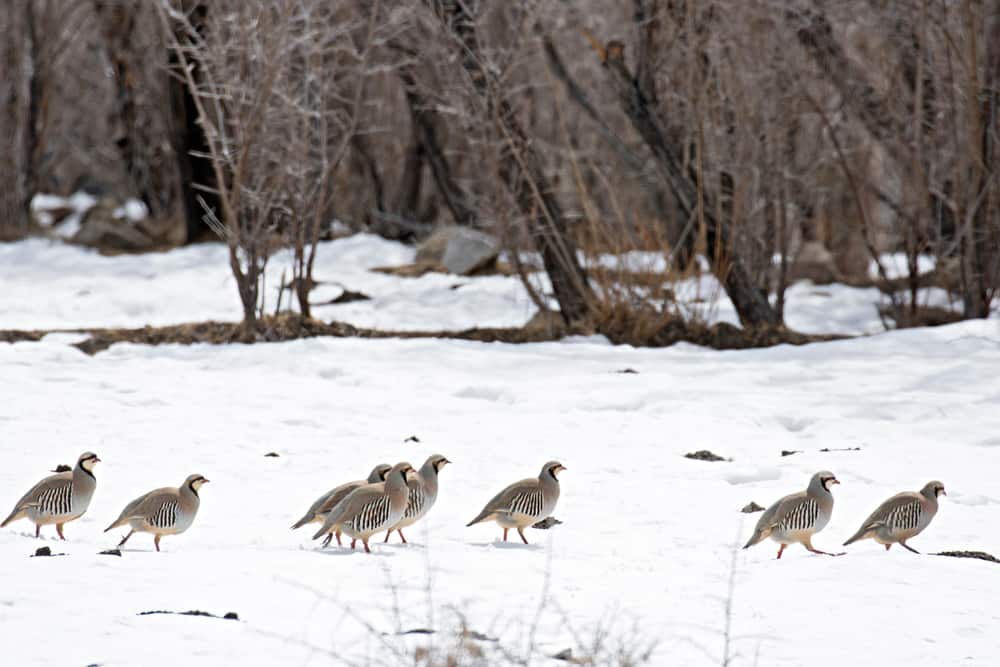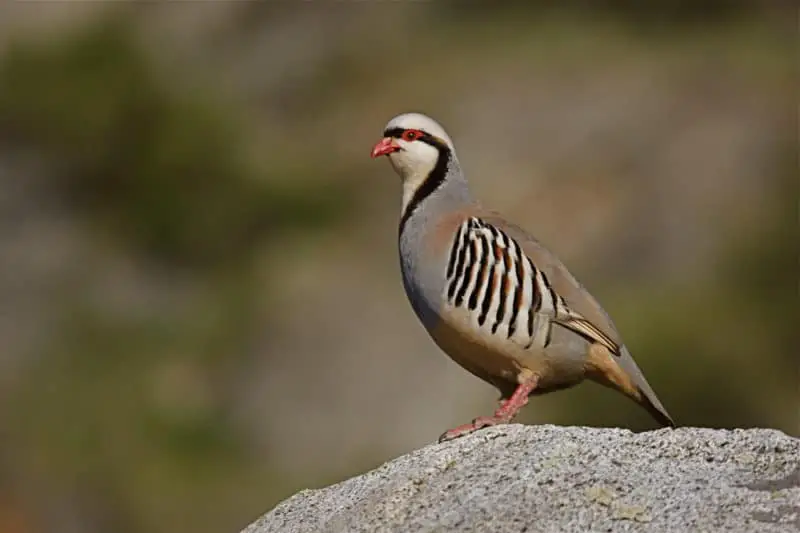The chukar partridge or chukar is an upland game bird that inhabits the high desert country of the western United States. These birds are actually imports to the North American Continent. They’re native to Parts of Europe, Asia, and Africa. Additionally, they’re the national bird in both Iraq and Pakistan.
The first Chukars came to the U.S in 1893 from Pakistan. Source
What Do Chukars Look Like ?
Chukars are round-bodied and almost quail-like in their construction. They’re larger than quail, though. From their beak to the beginning of their tail, they’re 13 to14 inches ( 33 to 36 cms) long. An average adult chukar weighs around 12 ounces (340 grams).
For coloration, they have sandy brown backs and dusty grey breasts. They also have a white splash on each side that is transversed by about a dozen vertical black bars. Additionally, they have a white face patch that extends under their chin and onto their throat. This white patch is surrounded by a black border that goes across their eyes and forehead. Their tails are dusty grey like their breasts. Finally, their beaks, legs, and feet are dark pink to red.

Chukar 
Gamble’s Quail
Chukar vs QUAIL
First of all, New World Quail, or quail native to the Americas, belong to a different family than chukars. Chukars belong to the Phasianidae family along with pheasants. New World Quail belong to the Odontophorid family, while Old World Quail or quail from Europe, Asia, Africa, and Australia belong to the Phasianidae family.
As stated above, chukars and quail are similar in body shape, but chukars are larger than quail. Adult chukars are 13 to 14 inches long and weigh around 12 ounces. In contrast, California Quail are 9 to11 inches and weigh six or seven ounces. Another quail example that you might find sharing habitat with chukars is Gamble’s quail. They’re very similar to the California quail in all phenotypical aspects, including length and weight.
Another distinguishing feature that both Gamble’s and California quail share with each other but not with chukars is a comma-shaped feather top knot.
Chukar Range
Chukars are native to and range over much of Asia, from India west into eastern Europe. There are also chukars in Africa. They have also been imported to North America and New Zealand. The following is a list of countries that have chukars.
Asia
- Afghanistan
- Armenia
- Bahrain (imported)
- China
- Cyprus
- India
- Iraq
- Iran
- Israel
- Jordan
- Kazakhstan
- Kyrgyzstan
- Lebanon
- Mongolia
- Nepal
- Oman
- Pakistan
- Russia
- Saudi Arabia
- Syria
- Tajikistan
- Turkmenistan
- Turkey
- United Arab Emirates
- Uzbekistan
- Yemen
Europe
- Armenia
- Azerbaijan
- Bulgaria
- Georgia
- Greece
- Italy
- Russia
- Ukraine
Africa
- Egypt
- South Africa (imported)
Oceana
- New Zealand (imported)
North America
- Canada (imported)
- Mexico (imported)
- The United States (imported)
In the United States, Chukars live in Utah, Nevada, California, Oregon, Washington, Colorado, Wyoming, Montana, New Mexico, Arizona, and Hawaii. In Hawaii, the birds inhabit parts of Molokai, Kauai, Maui, Lanai, Hawaii, and Oahu.
There are also chukars in northern Mexico and southern British Columbia in Canada.
Chukar Habitat
In the U.S, chukars live the high desert country in the western states. You’ll find them in desert canyons or on steep rocky hillsides, with a mixture of sage and grasses for ground cover. Cheatgrass, which is another import from Asia, is an important food source for them. Consequently, cheat grass-covered slopes are a good place to look for chukars.
The more rugged the landscape is, the better they seem to like it. If they sense any danger, whether, from a hunter or some other predator, they prefer to use flying as a last resort. Rather than flying, they’ll sprint uphill, dodging over and around boulders and brush as they go.
Chukars require a habitat that is close to a water source. However, if the plant material they’re feeding on is high enough in moisture content, they don’t need to drink every day. Source
What Do Chukars Eat?
Adults primarily eat plant material, such as grass seed, particularly cheatgrass seed. “Cheatgrass was accidentally imported to the United States in packing material. It’s on the list of invasive plant species in the U.S because it outcompetes other grasses in the more arid regions of western states.” Its seeds and its leaves provide plentiful food for chukars at times, though.
They also eat Crested Wheat Grass seeds, Sunflower seeds, Sage Brush leaves, and Pinyon Pine nuts. Even though adult chukars are primarily vegetarians, chukar chicks mostly eat insects.
These birds generally live far removed from agricultural areas but may venture to farm fields to feed on small grains in the wintertime.
Chukar Behavior
Chukars thrive in rugged desert and semi-desert country. They prefer terrain with canyons, cliffs, and steep hillsides. When they perceive danger, they tend to run uphill. Flying is what they do as a last resort. When they do fly, it tends to be downhill. They use their own gravity to increase the velocity of their flight.
If they are undisturbed, they’ll spend the morning hours foraging along a hillside as they gradually work their way to the canyon bottom or low point to water. “As stated earlier, if the plant materials they’re ingesting contain sufficient moisture, they won’t necessarily water every day.” After watering, they’ll forage through the rest of the day, generally working their way back uphill.
At night they roost in a safe place such as under an overhang or in a clifftop area. Additionally, chukers will sometimes roost in a tight circle, with each bird facing a separate direction. This helps them to conserve heat but also allows them to search in all directions for danger.
Chukars bathe in dust to keep parasites in check and their feathers in good condition. The small depressions that they scratch in the ground to bathe in are signs that chukars are in the area.
Chukar Mating Behavior
Chukars are monogamous. They breed once yearly. Breeding can occur from April through July. The timing depends on The area they live in and the accompanying environmental conditions. When breeding time occurs, males hold individual breeding territories. The male will execute different behaviors towards the female, including tilting his head, pecking at objects, and circling her. Occasionally he performs this circling maneuver with one wing extended downward.
Female Chukars make their nests in depressions scratched in the ground. They line these with grass and breast feathers. They will lay anywhere from 1 to 2 dozen eggs. The female does all the nest tending most of the time. Males will occasionally stay with the female through this time period, but they generally leave her once nesting begins.

Chukar Social Behavior
Chukars form groups out of multiple families called coveys. Unmated birds may also belong to a covey.
Final Thoughts
Chukars are tough well adapted upland game birds that live in the desert and semi-desert environments. They’re a challenge to hunt due to the terrain they live in and how they use it to their advantage. If you are going after chukars, get into reasonably good shape, or you won’t have a very enjoyable time.
You might also like Ring-Necked Pheasant – Krebs Creek
Facts About Ptarmigan – Krebs Creek
Recent Posts
The only venomous snakes in Washington State are Northern Pacific Rattlesnakes. The Northern Pacific Rattlesnake (Crotalus oreganus oreganus) is a sub-species of the Western Rattlesnake. Anyone...
Skunks are not classified as true hibernators. But they go into a state of torpor when the weather gets cold. Skunks are light sleep hibernators, along with opossums, bears, and raccoons. ...

